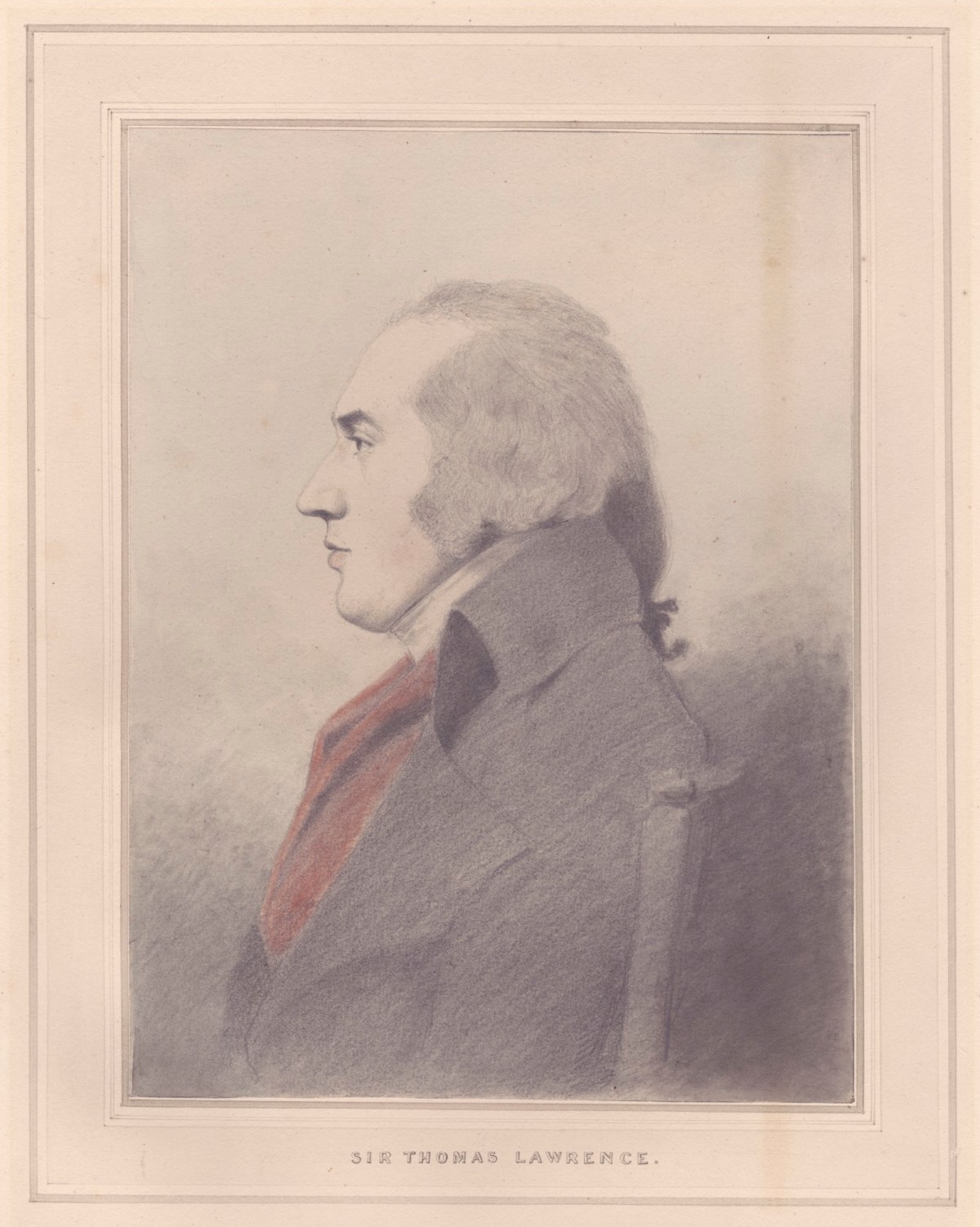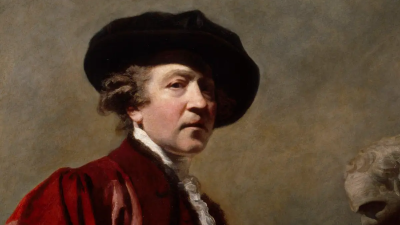
George Dance RA, Portrait of Sir Thomas Lawrence, P.R.A., Probably 2 February 1794.
Pencil, black chalk, with pink and red chalk (?, possibly a wash) and blue wash on cream wove paper. 254 mm x 192 mm. © Photo: Royal Academy of Arts, London.
This image is not available to download. To licence this image for commercial purposes, contact our Picture Library at picturelibrary@royalacademy.org.uk
Portrait of Sir Thomas Lawrence, P.R.A., Probably 2 February 1794
George Dance RA (1741 - 1825)
RA Collection: Art
A profile portrait of the celebrated portraitist, collector and President of the Royal Academy, Sir Thomas Lawrence. This drawing is unusually colourful for one of Dance's 'heads', featuring a light blue wash background and a red waistcoat as well as the customary touches of pink colouring to the lips and cheeks. It is possible that this is the result of re-touching by a later hand but equally there are sufficient examples of colourful profile portraits by Dance to accept this as his own work. William Gaunt suggested that the extra detail may be explained by the artist being 'a little baffled as a draughtsman by Lawrence's polished and formal presence'.
A child prodigy, the young Lawrence supported his bankrupt family by selling portraits in pastels and pencil. He moved to London in 1787 where his glamorous portraits achieved great success. Lawrence was elected an A.R.A. in 1791 and a full Academician in 1794. As President (from 1820) he was influential in the government's acquisition of the Angerstein collection for the National Gallery and of the Elgin Marbles for the British Museum.
Although no date is inscribed on the drawing, Joseph Farington's diary entry for February 2nd 1794 indicates that 'today Lawrence sat for a profile to Dance'.
Between 1793 and 1810, George Dance produced 53 profile portraits of his fellow Academicians. Dance, an architect by profession, made it his hobby to draw portraits of friends and well-known figures, providing what he called 'a great relaxation from the severer studies and more laborious employment of my professional life'.
However, the project to record the profiles of his fellow Academicians probably had a more serious commemorative impetus as Dance began this project in 1793 - the silver jubilee of the Royal Academy's foundation - and the majority of the portraits date from that year. Those drawn subsequently appear to have been part of a less concentrated attempt to record new members or to catch up on those who had been missed out in the initial series. Only two Academicians who were resident in Britain at the time were not drawn by Dance - Mary Moser and P. J. de Loutherbourg. Almost all of the drawings show the sitters in profile though there are some slight variations such as the portrait of Richard Cosway (03/3260) who is seated in a frontal pose with his head turned to the side (see also Thomson 04/1249, Opie 03/2666, Richard Westall 03/2657, Smirke 03/2655 and Nollekens 03/2650).
Although it was announced in The Oracle in 1793 (24th April 1793) that 'Mr George Dance the Architect has been drawing the profile portraits of the Academicians', the minutes of the General Assembly and the Academy's Council do not record any resolutions regarding these activities. Dance's private project could nevertheless have been officially supported or recognised by the institution. The uniform nature of these profile portraits had the advantage of being very democratic and, unlike other commemorative initiatives, giving each member equal merit.
Joseph Farington, a fellow RA, took a particular interest in Dance's project. His assistance in organising sittings for Dance and helping to arrange the drawings into 'volumes', is recorded in his famous diaries. This activity seems to have been closely linked to his own efforts to compile biographical information on living and dead artists, presumably with a view to publishing a history of the Academicians.
In July 1797, Farington's diaries record that he and Dance had been arranging the portraits into two volumes and were in discussion about how they should be bound. Markings on the original mounts suggest that the drawings were indeed bound although these bindings no longer survive. This is confirmed by J. H. Anderdon's recollection that he viewed some of Dance's heads in a bound volume in the RA Library in 1849 and 1864. Dance and Farington may have been trying to interest the Academy, or at least other Academicians, in their venture as Farington records that on January 29th 1799 that 'Fuseli and Mrs Fuseli, Opie and Mrs Opie drank tea with us - to see the Academy portraits by Dance' (Farington p. 1149). Although this activity did not result in a biographical publication, the idea evidently remained current for some time as, seven years later on December 31st 1806, Farington recorded that 'Dance called to desire me to have his collection of Portraits & to assist. with Biography. - Had doubts abt. World's [probably referring the publication of that name] remarks abt. it being out of his line - but now at time of life to pay little regard to such remarks to avoid [illegible] & to seek for ease & amusement etc'.
Although Farington's biographical work was never published, he and Dance were considering having the profile portraits engraved from as early as 1794. Farington's diary shows that on 9th August of that year Dance was already in discussion with an engraver on this matter. The engraver's name is not specified but in November the same year John Ogbourne had engraved Dance's profile of Lord Camden and was about to start work on that of Sir William Chambers. However, 72 of Dance's portaits were etched by William Daniell , including 16 of the Academicians' portraits, and were published along with brief biographical notes from 1802 onwards in 12 monthly parts and a further set of 142 unbound prints was published in 1851. The reaction to the original publication of Dance's profiles seems to have been positive but Farington recorded that 'Dance told me Landseer had in a Quarterly Critique been criticising His publication of Heads, & "That the eyes were too small, not like anything in nature in the proportions & that there was a want of Skull to the Heads" ' (10th May 1809) .
Related Objects:
There are 38 portrait drawings by Dance in the National Portrait Gallery collection, 41 in the British Museum, a small number at the V&A, Tate Britain and the John Soane Museum.
Object details
254 mm x 192 mm
Start exploring the RA Collection
- Explore art works, paint-smeared palettes, scribbled letters and more...
- Artists and architects have run the RA for 250 years.
Our Collection is a record of them.



